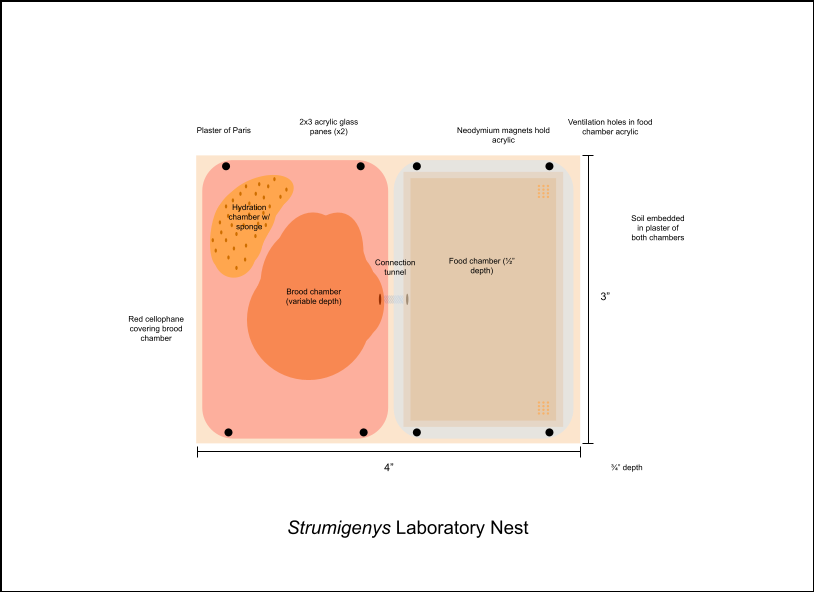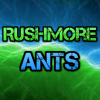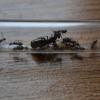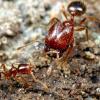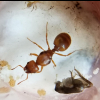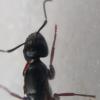About Us:
Ferox Formicae is a South Carolina-based ant shop, specializing in selling both common and rare southeastern ant species available nowhere else. Working with scientists from around the world, we know what is best for your ants, and are experienced in keeping some of the most finicky ants out there, and we believe sharing that information with other ant enthusiasts is very important in order to spread the love and knowledge of ants to anyone and everyone who needs it. We believe that properly researching the care for ant species is the key to success, which is why we have done all of that for you, providing you with as much information as possible for the ants you wish to keep, even those of which with little information on their care in captivity. With Ferox Formicae, all of your ant-related needs are met.
Ants For Sale:
Aphaenogaster fulva-rudis-texana complex spp.

Binomial Name: Aphaenogaster fulva-rudis-texana species complex
Common Name(s): Long-Legged & Winnow Ants
Classification: Formicidae, Myrmicinae, Stenammini
Description:
-Worker: 3.5-4 mm; A complex of many nearly indistinguishable species; Leggy and sporting medium to dark brown colorations with a lighter gaster tip;
-Gyne: 4-5 mm; Coloration from medium brown to red-brown with reddish gastric markings
-Male: 4 mm; Deep brown with a leggy build, small gaster and head
Distribution: Spread throughout the US and parts of Canada
Biology: An important part of many forest ecosystems as they help contribute to the spread of seeds; Nest are often under roots, at the base of trees, or under rotting logs, though sometimes nests are not associated with any structures in particular
Colony Form: Monogynous
Typical Colony Size: Rarely exceed 200 workers
Founding Method: Fully claustral
Care Level (1-5): 1.5; Very easy to care for as long as humidity is high
Bite or Sting: Have a sting, but are reluctant to use it
Diet: Pre-killed insects and seeds with elaiosomes such as pansies or violets
Nesting Medium: Nest in soil with inconspicuous nest entrances often marked by bits of insect exoskeletons
Formicarium Size: M
Temperature: 75-80 degrees F
Humidity: 50-70%
Hibernation: Hibernate only in the northern part of their range; Further south, queens continue to lay into the winter months
Pricing:
Mature colony: $70.00
Brachymyrmex patagonicus
Binomial Name: Brachymyrmex patagonicus
Common Name(s): Black Rover Ant
Classification: Formicidae, Formicinae, Myrmelachistini
Description:
-Worker: 1.5-2 mm; Small with a shiny black cuticle; Short and stout in build with a small petiole; Easily distinguished by it 9-segmented antennae, large eye, and sparse gaster pubescence
-Gyne: 4-5 mm; Nearly 3-times larger than workers and males; Lighter in color with denser pubescence and a very large gaster
-Male: 1.5 mm; Small and yellowish with a tiny, darker head; Very large eyes and ocelli; Common in large numbers at lights at night during the warmer months of the year
Distribution: Native to much of Central and South America, but has been introduced to the southern US
Biology: Workers are common in disturbed areas, and can often be seen as tiny black dots moving up and down tree trunks or across fences; Commonly referred to as sugar ants for their habit of feeding on sweet, sugary foods, especially when foragers are seen in houses
Colony Form: Polygynous
Typical Colony Size: 300-500 workers
Founding Method: Fully claustral
Care Level (1-5): 2; One of the easier ants to care for out there, though can be hard to contain due to their small size
Bite or Sting: None
Diet: Particularly like sugary foods such as sugar water, honey, and fruits, but will also feed on pre-killed insects
Nesting Medium: Nests can be found under rocks or other objects, within rotting logs, hollow twigs, inside of houses, at the base of trees, and in arboreal settings
Formicarium Size (Mature Colony): M
Temperature: 70-75 degrees F
Humidity: 55-65%
Hibernation: None
Pricing:
$5.00 per queen (Pre-order only)
Camponotus (Camponotus) castaneus
Binomial Name: Camponotus (Tanaemyrmex) castaneus
Common Name(s): Chestnut Carpenter Ant
Classification: Formicidae, Formicinae, Camponotini
Description:
-Minor: 7-8 mm; Light orange coloration throughout with a darker head and gaster tip; The head is small and elongated
-Major: 9-10 mm; Light orange main body with a reddish head, sometimes dark enough to be confused with the similar americanus; The head is large and broad with large mandibles and normal sized eyes
-Gyne: 13-15 mm; Gorgeous deep orange-red throughout with a glossy sheen makes them stand out amongst females of other North American species
-Male: 9-10 mm; Light orange throughout, most often lighter than the workers
Distribution: Spread throughout the eastern US and rare in parts of Canada
Biology: Rare in all areas but states bordering the Atlantic Ocean, elsewhere replaced by the similar americanus; Colonies of this gorgeous Camponotus can be found in mixed hardwood forests under large rocks on the forest floor, more rarely under logs or at the base of trees
Colony Form: Monogynous
Typical Colony Size: 1000-3000 workers
Founding Method: Fully claustral
Care Level (1-5): 3; Finicky eaters and notoriously difficult to get past the founding stage
Bite or Sting: Can bite and spray formic acid
Diet: Watered down honey, sugar water, pre-killed insects, fruit flies
Nesting Medium: Form large, elaborate colonies in the wild that can extend down many feet, often under rocks or at the base of trees, less commonly under or inside of rotting logs
Formicarium Size (Mature Colony): L-XL
Temperature: 75-80 degrees F
Humidity: 40-60%
Hibernation: Yes; Hibernation time depends on region
Pricing:
Single queen: $45.00
Incipient colony: $70.00
Camponotus (Camponotus) chromaiodes

Binomial Name: Camponotus (Camponotus) chromaiodes
Common Name(s): Ferruginous Carpenter Ant, Red Carpenter Ant
Classification: Formicidae, Formicinae, Camponotini
Description:
-Worker: 6-10 mm; Matte black base color with red highlights at the later portions of the mesosoma, on the petiole, on the first gastric tergite, and on the legs; Certain forms are more-or-less fully black with deep red highlights on the legs and mesosoma; These forms can be difficult to distinguish from pennsylvanicus workers; Gaster covered with golden, appressed pubescense, similar to that seen in pennsylvanicus
-Major: 11-13 mm; Similar to minor and media workers, but with a far broader head
-Gyne: 15-17 mm; Similar to the workers, but with more red and less of the distinct, appressed gastric hairs; Wings yellowish at their trailing edges, with the yellow fading towards the trailing edge
-Male: 9-11 mm; Nearly fully matte black, but with darker red highlights on the legs; Wings similar to that of gynes, but a bit lighter
Distribution: Spread throughout the eastern US, but replaced throughout most of its range by the related C. pennsylvanicus
Biology: Often forage diurnally, but during optimal conditions, foragers can be seen at night; Workers can often be seen tending to Homopterans and Hemipterans on low-growing vegetation, usually no more than a few meters off the ground
Colony Form: Monogynous/pleometrotic
Typical Colony Size: 1500-3000 workers
Founding Method: Fully claustral
Care Level (1-5): 2.5; Like most Camponotus, can be difficult to found, but after founding, they are fairly easy to care for; Colonies can be fairly aggressive when larger, and are occasionally difficult to contain, and should never be kept in material they can chew through, such as wood and plaster
Bite or Sting: Can deliver a painful bite and spray formic acid
Diet: Mainly prefer sweets, but are quick to go for pre-killed insects, as well as live ones
Nesting Medium: Nest in wood and occasionally in soil, often under objects such as rotting logs or roots; Colonies can also be found at the base of trees or, rarely, within rotting portions of live or dying trees
Formicarium Size (Mature Colony): XL
Temperature: 65-70 degrees F
Humidity: 45-55%
Hibernation: Yes; Hibernate starting from late Fall into early Spring, shorter amounts of time in more southern areas
Pricing:
Single queen: $40.00
Camponotus (Myrmentoma) decipiens

Binomial Name: Camponotus (Myrmentoma) decipiens
Common Name(s): Deceptive Arboreal Carpenter Ant; Smaller Bicolored Carpenter Ant
Classification: Formicidae, Formicinae, Camponotini
Description:
-Worker: 3.5-7.5 mm; Bicolored with a red head and mesosoma and a shiny black gaster; Can be separated from discolor by its lack of shallow pits and corresponding hairs on the gena; Separated from nearcticus and snellingi by its coloration, nearcticus being black with a deep red mesosoma to concolorous black and snellingi being bicolored red and black to yellow and black, the head, mesosoma and first two gastric tergites being red or yellow with a black gaster
-Gyne: 9-10 mm; Similar in color and design to worker; Body strongly elongated in comparison to that of the workers
-Male: 4.5-5 mm; Concolorous black throughout, sometimes with a lighter mesosoma
Distribution: Spread throughout much of the southern US; Absent in the far west
Biology: Colonies of this species are typically small and found in arboreal settings; Workers can often be seen foraging on low vegetation and tending to sap-sucking Homopterans
Colony Form: Monogynous/pleometrotic
Typical Colony Size: 100-300 workers
Founding Method: Fully claustral
Care Level (1-5): 1; Easy to care for and easier to found than larger Camponotus species; A great beginner species
Bite or Sting: None
Diet: Prefer sweet, sugary foods, but will also feed on pre-killed insects and fruit flies
Nesting Medium: Often nest in arboreal settings, usually in hollowed out twigs or branches
Formicarium Size (Mature Colony): M
Temperature: 70-80 degrees F
Humidity: 40-50%
Hibernation: Yes; Hibernate from October to late February, but times may vary depending on location
Pricing:
Mature colony: $110.00
Camponotus (Myrmentoma) nearcticus

Binomial Name: Camponotus (Myrmentoma) nearcticus
Common Name(s): Pine Branch Carpenter Ant; Nearctic Carpenter Ant; Smaller Carpenter Ant
Classification: Formicidae, Formicinae, Camponotini
Description:
-Worker: 3.5-7.5 mm; Populations from this region are typically fully concolorous shiny black, but further north, workers may be bicolored black with a red mesosoma; Distinguished from caryae by the lack of pits and corresponding erect hairs on the gena; Separated from decipiens and snellingi by the coloration alone
-Gyne: 9-10 mm; Similar in color to workers but with a more elongated body and a far more robust build in the mesosoma area
Male: 4.5-5 mm; Concolorous black
Distribution: Ranging throughout much of the continental US and into Canada
Biology: Colonies can often be found in pine forest of in mixed hardwood forest and are often associated with pine trees of the genus Pinus; Colonies are almost always arboreal, but can occasionally be found in terrestrial settings
Colony Form: Monogynous/pleometrotic
Typical Colony Size: 500-1000 workers
Founding Method: Fully claustral
Care Level (1-5): 1.5; A hardy and tolerant species, but can be a bit difficult to get past the found stage
Bite or Sting: None
Diet: Tend to prefer sweet foods, but will also accept a wide variety of pre-killed insects
Nesting Medium: Often nest in arboreal settings in pine or other trees, usually in hollow twigs or branches or under bark; Nests can occasionally be found in fallen logs or branches, under logs on the forest floor, or at the base of trees
Formicarium Size (Mature Colony): M-L
Temperature: 75-85 degrees F
Humidity: 35-45%
Hibernation: Yes; Hibernate from around November to February, often coming out on warmer days to forage if conditions are optimal
Pricing:
Single queen: $35.00 (Pre-order only)
Crematogaster ashmeadi

Binomial Name: Crematogaster ashmeadi
Common Name(s): Ashmead's Acrobat Ant
Classification: Formicidae, Myrmicinae, Crematogastrini
Description:
-Worker: 2.5-3 mm; Small shiny and black with sparse pilosity and short propodeal spines
-Gyne: 5 mm; Large-bodied with a shiny black cuticle; Propodeal spines short and pilosity fairly dense on gaster
-Male: 3 mm; Small head and gaster with a massive mesosoma; Eyes average sized and ocelli fairly large
Distribution: Spread throughout the Southeastern US
Biology: A small, mostly arboreal species often seen foraging on fences, low lying vegetation, and in trees; Larger colony workers may be seen foraging on the ground, across pavement, etc.
Colony Form: Polygynous/pleometrotic
Typical Colony Size: 300-500 workers
Founding Method: Fully claustral
Care Level (1-5): 1; Easy to care for as long as they are fed well
Bite or Sting: Can bite and exude chemicals into the cut
Diet: Watered down honey, sugar water, pre-killed insects, and fruit flies
Nesting Medium: Nest in hollow twigs and branches in arboreal settings, often 2 meters or higher off the ground
Formicarium Size (Mature Colony): M-L
Temperature: 70-80 degrees F
Humidity: 50-65%
Hibernation: Yes; Require a short hibernation period during the cooler months
Pricing:
Mature colony: $80.00
Crematogaster minutissima

Binomial Name: Crematogaster minutissima
Common Name(s): Forest Floor Yellow Acrobat Ant, Minute Acrobat Ant
Classification: Formicidae, Myrmicinae, Crematogastrini
Description:
-Worker: 2-3 mm; A small Crematogaster species with a unique bright yellow coloration and fairly dense pilosity; Separated from the similar C. missouriensis by the lack of and granulate sculpturing on the mesosoma
-Gyne: 3.5-4 mm; Similar in appearance to workers but with a robust mesosoma, darker color, and denser pilosity, especially on the gaster
-Male: 2 mm; Tiny and pale yellow
Distribution: Found throughout much of the southern US
Biology: Colonies commonly found under objects such as logs and rocks and inside of rotting wood
Colony Form: Strictly polygynous
Typical Colony Size: 100-500 workers
Founding Method: Fully claustral
Care Level (1-5): 2; Fairly easy to care for but require high humidity and are hard to maintain as they are so small
Bite or Sting: None
Diet: Watered down honey, sugar water, and pre-killed insects
Nesting Medium: Colonies nest in soil under objects, rotting wood, and under the bark of dead, often fallen, trees
Formicarium Size (Mature Colony): S-M
Temperature: 65-70 degrees F
Humidity: 60-75%
Hibernation: None; Queens continue to lay throughout the winter in most parts of their range
Pricing:
Mature colony: $67.00
Cyphomyrmex rimosus

Binomial Name: Cyphomyrmex rimosus
Common Name(s): Rimose Fungus-Farming Ant, Little Fungus-Gardener Ant
Classification: Formicidae, Myrmicinae, Attini
Description:
-Worker: 2-2.5 mm; A small short stout and leggy ant with strongly expanded frontal lobes, easily recognizable from similar species such as minutus by its dark grayish coloration, strongly pronounced mesosomal tubercles, and weakly contrasting mesosomal coloration
-Gyne: 3 mm; Similar in design to workers but more robust with pronotal humeral tubercles distinct when viewed dorsally
-Male: 2.5 mm; Dark in color with a head similar to workers but with larger eyes and truncated edges of the frontal lobes
Distribution: Native to much of Central and South America; Introduced to the Southeastern US
Biology: A fungus farming species often seen in disturbed areas carrying bits of debris back to the nest, often frass, bits of plant material, or pieces of insect exoskeletons; The nest entrances are inconspicuous and colonies are often found under objects such as rocks or logs or within the colonies of other, more aggressive ant species such as Solenopsis invicta or Wasmannia auropunctata; Workers curl up and feign death when disturbed
Colony Form: Usually monogynous, though can occasionally be polygynous
Typical Colony Size: 100-150 workers
Founding Method: Semi-claustral
Care Level (1-5): 4; The yeast can be difficult to keep alive, and if the ants go without water for even a few hours or if their humidity drops too low, they are quick to die; The ants are also very messy, and often leave fungus substrate out to mold
Bite or Sting: None
Diet: Feed on a form of unicellular yeast (Tyridiomyces formicarum) farmed with bits of organic debris such as crushed insect exoskeletons, frass, and bits of plant debris; Occasionally accept watered down honey and sugar water
Nesting Medium: Nest in soil, often under objects, usually in or near the nests of other ant species; Occasionally nest in rotting wood or in crotches of trees filled with soil
Formicarium Size (Mature Colony): S-M
Temperature: 65-75 degrees F
Humidity: 60-75%
Hibernation: Not needed, but recommended in northern areas
Pricing:
Mature colony: $120.00
Myrmecina americana
Binomial Name: Myrmecina americana
Common Name(s): Common Mite-Eating Ant
Classification: Formicidae, Myrmicinae, Crematogastrini
Description:
-Worker: 3 mm; Deep brown to reddish brown and heavily sculptured throughout; Two pairs of propodeal spines, the upper pair shorter and projected upward; Head squarish and mandibular and clypeal teeth large and distinct; Gaster fairly large and shining
-Gyne: 3.5 mm; Similar to workers and only slightly larger; Mesosoma large and upper propodeal spine pair absent
-Male: 3 mm; Small and brownish with an elongated build; Sculpturing sparse and nearly absent
Distribution: Present throughout much of North America from as far north as Quebec down to Florida
Biology: Common, but highly inconspicuous due to their slow movements, cryptic coloration, and their death-feigning habits; Foragers can be easily uncovered by sifting through leaf litter in shaded areas, though nests are rare and difficult to find
Colony Form: Monogynous
Typical Colony Size: 100-150 workers
Founding Method: Semi-claustral
Care Level (1-5): 3; Can be fairly finicky with diet and hydration, as is the case for most cryptic ant species
Bite or Sting: None
Diet: Considered mite-specialist predators, but will also feed on springtails, fruit flies, and pre-killed crickets
Nesting Medium: Nests can be found under rocks, logs, or within rotting wood, almost always on the edges of frequently flooded areas
Formicarium Size (Mature Colony): S
Temperature: 65-70 degrees F
Humidity: 65-75%
Hibernation: Yes
Price:
Mature colony: $55.00
Nylanderia faisonensis
Binomial Name: Nylanderia faisonensis
Common Name: Woodland Crazy Ant
Classification: Formicidae, Formicinae, Lasiini
Description:
-Worker: 1.9-2.6 mm; Uniform deep brown with a black gaster to nearly entirely black; Scapes and mandibles yellow, with white meso and metacoxae which strongly contrast with the rest of the body; Near lack of any pubescence on the mesosoma or gaster; Can be distinguished from the similar wojciki by the presence of 5 or more macrosetae on the antennal scapes, as opposed to less than 5 in wojciki; In addition to this, wojciki tends to be bicolored with a lighter mesosoma
-Gyne: 3.4-4.1 mm; Light brown, often with a slightly darker gaster; Meso and metacoxa only slightly contrasting with the rest of the body, often being a lighter shade of brown; Cuticle covered in dense pubescence
-Male: 1.9-2.4 mm; Medium brown throughout, often with a darker gaster; Similar to workers, meso and metacoxae are pale whitish in color; Most of cuticle--excluding gaster--with dense pubescence; Resembles a worker in general form and proportion
Distribution: Common throughout the eastern US as far north as southern Michigan
Biology: One of the most common forest dwelling ants in the eastern US, a submissive and tolerant species often seen living around large populations of other, larger ant species
Colony Form: Monogynous
Typical Colony Size: 200-500 workers
Founding Method: Fully claustral
Care Level (1-5): 1.5; Fairly easy to care for, but can be difficult to contain due to their small size and skittish nature
Bite or Sting: None
Diet: Honey, sugar water, fruit, pre-killed insects, fruit flies, springtails
Nesting Medium: Nest in soil, often under objects, in wood, or in hollow twigs or nuts on the forest floor
Formicarium Size (Mature Colony): S-M
Temperature: 70-80 degrees F
Humidity: 55-65%
Hibernation: Not necessary
Pricing:
Incipient colony: $25.00
Mature colony: $75.00
Pheidole crassicornis
Binomial Name: Pheidole crassicornis
Common Name(s): Thick-Scaped Big-Headed Ant
Classification: Formicidae, Myrmicinae, Attini
Description:
-Minor: 2.5 mm; Variable in coloration, ranging from dark brownish-black to yellowish-brown; Cuticle opaque and feebly sculptured
-Major: 3-3.2 mm; Dark brownish-black with a deep red head to bicolored red and brown with a shiny black gaster to yellowish-brown with a light red head; Light sculpturing on head stopping at around the midpoint; Scape wide, widest at the base; Can be distinguished from the similar and widespread diversipilosa by the lack of dense, erect setae on the gaster surface
-Gyne: 4-4.5 mm; Coloration and sculpturing similar to the major workers of the species
-Male: Undescribed
Distribution: Ranges throughout much of the southern US
Biology: Fairly uncommon throughout much of its range; Mounds are typically inconspicuous, but in clay soils mounds slightly resemble those created by Trachymyrmex septentrionalis
Colony Form: Monogynous
Typical Colony Size: Likely around 500-1000 workers
Founding Method: Fully claustral
Care Level (1-5): 2-3; While care information for this rarely species is currently sparse, care for this species is likely similar to that of other medium to large-sized Pheidole species
Bite or Sting: Workers are quick to bite when under attack, but bites are relatively painless
Diet: Primarily feed on pre-killed insects, but also enjoy sugar water, honey water, fruit, and other sweets
Nesting Medium: Nest in soil often under objects, but occasionally make nests in open soil, creating small, crescent-shaped mounds
Formicarium Size (Mature Colony): M-L
Temperature: 65-70 degrees F
Humidity: 40-50%
Pricing:
Mature colony: $180.00
Prenolepis imparis
Binomial Name: Prenolepis imparis
Common Name(s): Winter Ant; Fat-Bellied Ant; False Honey Ant
Classification: Formicidae, Formicinae, Lasiini
Description:
-Worker: 3-4 mm; Medium brown to black with a shiny cuticle; Erect macrosetae covering head, mesosoma, and gaster; Mesosoma slender with a distinct mesonotal groove; Large, hump-backed gaster filled with liquid fat in repletes
-Gyne: 7.5-8.5 mm; Medium brown with reddish mesosoma, but can be nearly black in some western populations; Large-bodied with a massive gaster; Entire cuticle covered in dense pubescence
-Male: 3.5-4 mm; Small and black in color with dense pubescence and a shiny cuticle; Small head with large eyes and ocelli
Distribution: Spread throughout much of the US, Canada, and into Central America
Biology: Active during late Autumn, Winter, and into early Spring; Colonies contain many repletes filled with liquid food, often with liquid fat reservoirs as opposed to the sugary reserves of the true honey ants in the genus Myrmecocystus and Camponotus; Foraging trails can often be seen on the sides of trees going up into the canopy to farm sap-sucking Homopterans
Colony Form: Polygynous
Typical Colony Size: 500-1000 workers
Founding Method: Fully claustral
Care Level (1-5): 2; Once past the founding stage, colonies are fairly easy to care
Bite or Sting: None
Diet: Sugary foods and pre-killed insects
Nesting Medium: Often nest in sandy or clay soil, forming low, conspicuous mounds with wide entrance holes; Nests are deep and replete chambers can often be found under rocks
Formicarium Size (Mature Colony): M-L
Temperature: 60-70 degrees F
Humidity: 55-65%
Hibernation: Go into a state of diapause during the summer and are active only during the cooler months of the year, from around October to early April
Pricing:
Single queen: $40.00
Pseudomyrmex ejectus

Binomial Name: Pseudomyrmex ejectus
Common Name (s): Shining Dark Slender Twig Ant; Smaller Bicolored Slender Twig Ant
Classification: Formicidae, Pseudomyrmecinae, Pseudomyrmecini
Description:
-Worker: 4 mm; A small shiny black ant with large eyes, short antennae, and short legs, complete with an elongated build
-Gyne: 4.5 mm; Similar to the worker, but larger with a slightly larger mesosoma
-Male: 4 mm; Lighter in coloration than the workers and gynes
Distribution: Found throughout much of the Southeastern United States and extending down into Central America as far North as Panama
Biology: A small arboreal species nesting no lower than 2 meters off the ground; Forage in the canopy for small insects and sweet plant secretions such as nectar from flowers and honeydew from sap-sucking insects; Can often be seen foraging lower in the canopy, often foraging on fences and other similar structures
Colony Form: Polygynous
Typical Colony Size: 300-1000 workers
Founding Method: Semi-claustral or colony fragmentation
Care Level (1-5): 3; Can be finicky with what they choose to nest in, along with being escape masters due to their slender build, amazing eyesight, and arboreal habits
Bite or Sting: Can sting, but very rarely do so; Sting rates a 3 on Schmidt Sting Pain Index
Diet: Watered down honey, sugar water, and pre-killed mealworms and smaller insects
Nesting Medium: Colonies can be found in the wild living inside hollow twigs no more than a few millimeters in diameter; As such, colonies prefer to nest in either a naturalistic setup or within a very slender test tube or some vinyl tubing; Colonies will not nest in anything that is too damp
Formicarium Size (Mature Colony): S-M
Temperature: 75-80 degrees F
Humidity: 30-40%
Hibernation: None; Queens continue to lay throughout the winter months
Pricing:
Mature colony: $125.00
Solenopsis molesta complex spp.

Binomial Name: Solenopsis molesta species complex
Common Name(s): Thief Ants
Classification: Formicidae, Myrmicinae, Solenopsidini
Description:
-Worker: 1-2 mm; A complex of taxonomically difficult, tiny ants that cannot be separated without extremely high magnification or DNA tests; Usually concolorous yellow, but can occasionally be darker, black in some species
-Gyne: 2-4.5 mm; Concolorous yellow, usually with a darker head; Eye large and well-developed; Distinguished from females of texana by its larger size, larger and more developed eyes and darker coloration
-Male: 2-3 mm; Bicolored with a brown head and gaster with a yellow mesosoma; Antennae yellow; Abundantly hairy throughout
Distribution: Spread throughout much of the New World
Biology: Found in all habitat types; Some species are arboreal
Colony Form: Polygynous
Typical Colony Size: 500-10000 workers
Founding Method: Fully claustral
Care Level (1-5): 2; Fairly easy to care for, but can be difficult to contain due to their small size; Eat readily most foods offered to them
Bite or Sting: None
Diet: Ant brood, pre-killed insects, sugary foods
Nesting Medium: Nest in nearly all microhabitats
Formicarium Size (Mature Colony): S-M
Temperature: 65-75 degrees F
Humidity: 55-75%
Pricing:
Mature colony: $60.00 +$10 for extra queens
Solenopsis invicta

Binomial Name: Solenopsis invicta
Common Name(s): Red Imported Fire Ant
Classification: Formicidae, Myrmicinae, Solenopsidini
Description:
-Minor & Worker: 3 mm; Hairy with a dark red to reddish-brown coloration; Orange spot on first gastral tergite; Shiny cuticle
-Major: 5 mm; Similar to workers but with a larger head and often having a brighter coloration
-Gyne: Variable, but usually bicolored with a deep red head, mesosoma, and first gastric tergite, with the rest of the gaster shiny black; Occasionally darker or brighter, almost always with two darker stripes on the mesosoma
-Male: Shiny black with a tiny head and large eyes and ocelli
Distribution: Native to much of South America but has been introduced to the neotropics around the world, causing devastation wherever they've been introduced
Biology: Highly aggressive, often creating large mounds in soil (usually of a sandy or clay consistency) or within rotting logs
Colony Form: Polygynous
Typical Colony Size: 50000-1000000 workers
Founding Method: Fully claustral
Care Level (1-5): 3; Easy starting out, but colonies grow extremely fast and can be extremely difficult to maintain once they get larger
Bite or Sting: Bite and sting; Sting rates a 1.2 on the Schmidt Sting Pain Index
Diet: Watered down honey, sugar water, pre-killed insects and fruit flies
Nesting Medium: Nest in soil and occasionally within rotting logs
Formicarium Size (Mature Colony): XXL
Temperature: 70-80 degrees F
Humidity: 55-65%
Hibernation: None
Pricing:
Single queen: $5.00
Incipient colony: $15.00
Mature colony: $50.00
Temnothorax curvispinosus

Binomial Name: Temnothorax curvispinosus
Common Name(s): Yellow Woodland Creeper Ant; Curve-Spined Acorn Ant
Classification: Formicidae, Myrmicinae, Crematogastrini
Description:
-Worker: 2.4 mm; Yellow to orange-yellow base color, often with black gastral markings; Cuticle feebly sculptured throughout with striations present on the surface of the head and pronotum; Propodeal spines long and curved down and inward
-Gyne: 3-3.3 mm; Darker in coloration than workers, usually brownish yellow with a yellow-black striped gaster with the gaster darkening and the stripes diminishing in visibility as the queens age; Propodeal spines long, but shorter in comparison to those seen in the workers
-Male: 2 mm; Small and pale off-white in color; Head and gaster often darker in color, the head very much so; Legs and antennae nearly white; Eyes and ocelli prominent
Distribution: Spread throughout the eastern US and into Canada; Range extends as far west as Arizona
Biology: Workers can often be seen foraging in leaf litter or on low-lying vegetation or fences; Foragers can often be found at honey or peanut butter baits placed on tree trunks or fences
Colony Form: Polygynous
Typical Colony Size: 50-200 workers
Care Level (1-5): 1; A hardy and tolerant beginner species
Bite or Sting: None
Diet: Honey, sugar water, peanut butter, pre-killed insects
Nesting Medium: Nest within hollow twigs, rotting nuts buried in the leaf litter; Occasionally arboreal
Formicarium Size (Mature Colony): Small
Temperature: 65-70 degrees F
Humidity: 50-65%
Pricing:
$15.00 per queen (Pre-order only)
Mature colony: $45.00
Trachymyrmex septentrionalis

Binomial Name: Trachymyrmex septentrionalis
Common Name(s): Northern Fungus Farming Ant, Northern Tuberculate Fungus Ant, Northern Pygmy Leafcutter Ant
Classification: Formicidae, Myrmicinae, Attini
Description:
-Workers: 3.5 mm; Brownish in color with lighter circular marks on either side of the first gastric tergite at its base; Mesosoma spiny and highly tuberculate with tubercles covering the surface of the first gastric tergite; Moderately polymorphic, but nowhere near the polymorphism displayed in close relatives such as Acromyrmex or Atta
-Gyne: 5 mm; Similar in design to the workers but with a more robust build and often having more extensive and noticeable light markings on the first gastic tergite; The pronotal humeral spines are highly pronounced in dorsal view
-Male: 3-3.5 mm; Medium brown with a large gaster and a high level of texturing on the head
Distribution: Spread throughout much of North America, as far north as Long Island, New York, and as far west as parts of Arizona
Biology: A fungus gardener with high levels of agricultural development (there are three levels of Attine development, low, high, and leaf-cutting), bringing material such as frass, oak catkins, and even cut pieces of young leaves, grasses, and flower petals; Fungus gardens get to be very large (nearly baseball-sized!), diminishing in summer and winter to just enough to sustain the colony
Colony Form: Monogynous/pleometrotic
Typical Colony Size: 200-500 workers
Founding Method: Semi-claustral
Care Level (1-5): 4; The ants themselves are not too hard to care for, but the fungus is very finicky and needs very high humidity in order to thrive, and even then can die without warning; The setup needs to be fairly large in order to accompany the large size of their fungus gardens
Bite or Sting: None
Diet: Feed specifically on a species of Leucoagaricus fungus which they farm with oats, frass, oak catkins, grasses, leaves, and flower petals (in my experience they prefer rose petals)
Nesting Medium: Nest in well drained soil in open areas; They're not to picky about location, nesting in sand, clay, and humus, as long as it's somewhere fairly open (though I've seen colonies in closed-canopy forests) and that has plenty of caterpillars around to produce the frass they use to farm their fungus; All populations I've encountered have been near to oak trees (Quercus)
Formicarium Size (Mature Colony): M-L
Temperature: 70-80 degrees F
Humidity: 85-95%
Hibernation: Yes; Enter a state of estivation during the hot summer months in warmer areas and hibernate during the winter in temperatures under 60 degrees F, usually from November to February
Pricing:
Single queen: $40.00
Small colony: $85.00
Mature colony: $160.00
*note* If you are interested in a species not listed here, please PM or email me
Species I'm Looking To Obtain (Willing To Trade For):
- Aphaenogaster mariae (Mary's Long-Legged Ant)
- Aphaenogaster tennesseensis (Curve-Spined Long-Legged Ant)
- Camponotus floridanus (Florida Carpenter Ant)
- Camponotus socius (Sandhills Carpenter Ant)
- Discothyrea testacea (Southern Pygmy Egg-Eating Ant)
- Gnamptogenys triangularis (Spine-Thighed Grooved Ant)
- Pogonomyrmex badius (Florida Harvester Ant)
- Pogonomyrmex occidentalis (Western Harvester Ant)
- Proceratium spp. (Egg-Eating Ants)
- Pseudomyrmex gracilis (Graceful Bicolored Twig Ant)
- Strumigenys spp. (Mustache and Pygmy Snap-Jaw Ants)
- Tetramorium bicarinatum (Larger Imported Pennant Ant)
- Tetramorium lanuginosum (Downy Pennant Ant)
- Tetramorium simillimum (Similar Yellow Pennant Ant)
Shipping:
Ants can be both shipped via USPS to anywhere in South Carolina or picked up in-person, which I, along with most of my customers, seem to recommend, especially due to the fact that information can be given about the colony(s) face-to-face. Pick-ups tend to happen at about the halfway point between either party due to convenience purposes. If shipping is the desired option, shipping and handling costs must be paid in-full, which will vary depending on location. There is a live arrival guarantee as long as temperatures are between 50 and 85 degrees F. Any higher or lower, and the ants cannot be guaranteed live upon arrival, but will be shipped with either a heat or cool pack, depending on the conditions. Unless stated otherwise (i.e. Crematogaster cf. laeviuscula), ants are properly identified to species upon arrival with state-of-the-art lab materials and several years of ant-identifying experience, in order for you to have the best ant-keeping experience and being able to have access to all of the information known for that particular species.
Contact:
Email: feroxformicae@gmail.com
Phone number: 1(803) 719-3414 (text only)
YouTube: Ferox Formicae
Twitter: Cloud Dandridge; @Ferox_Formicae




























